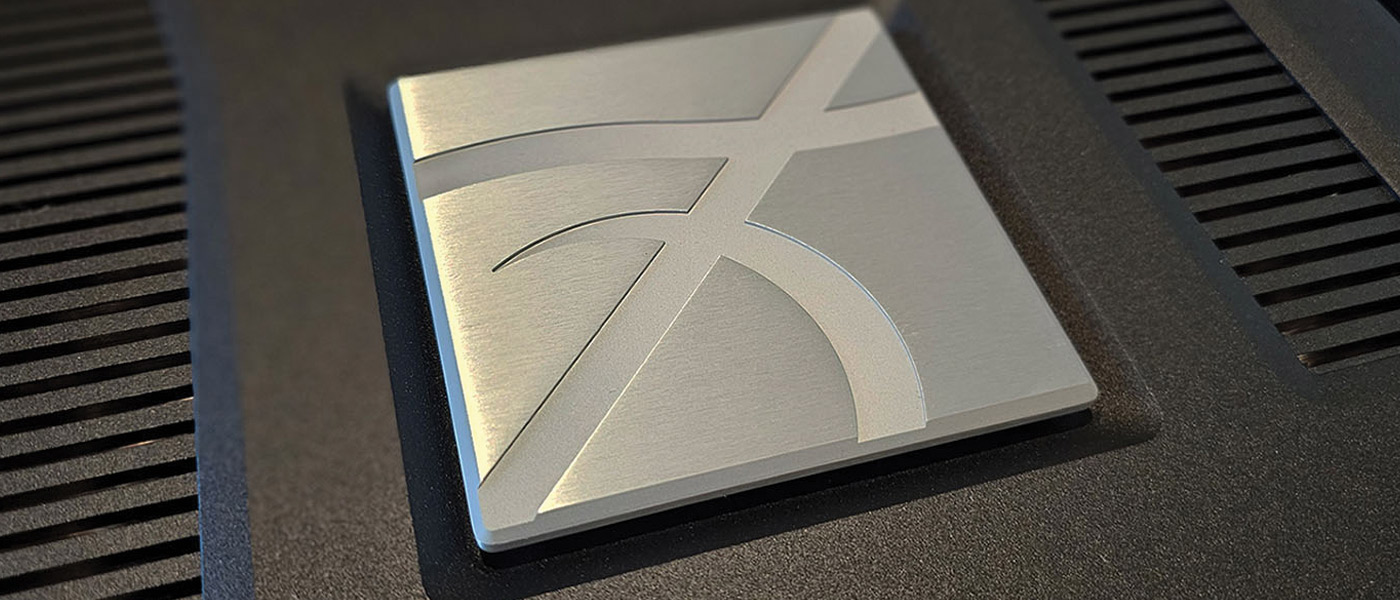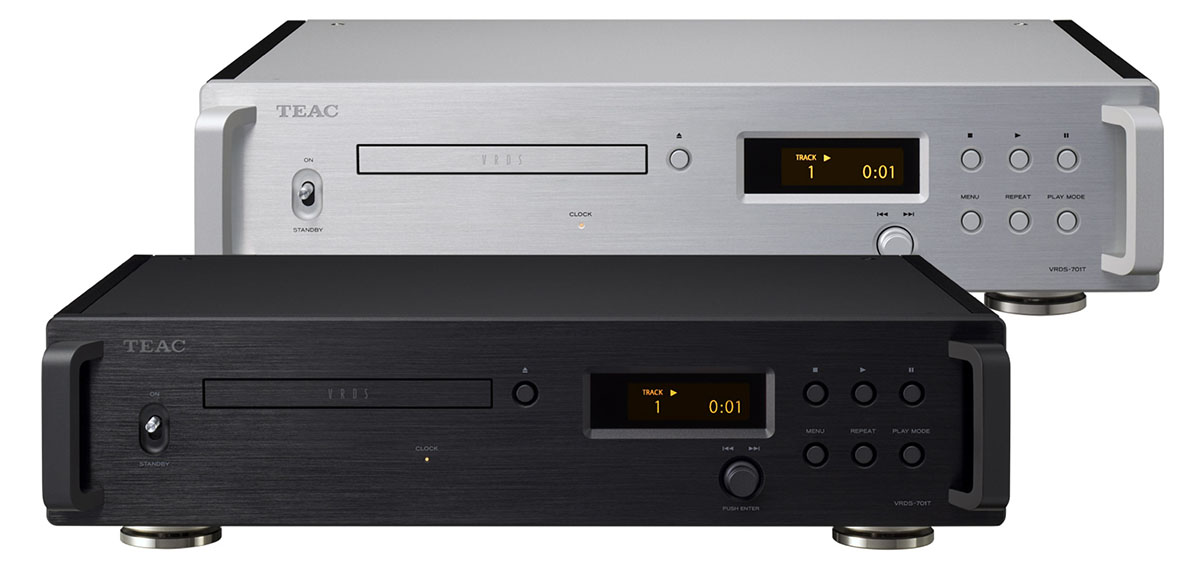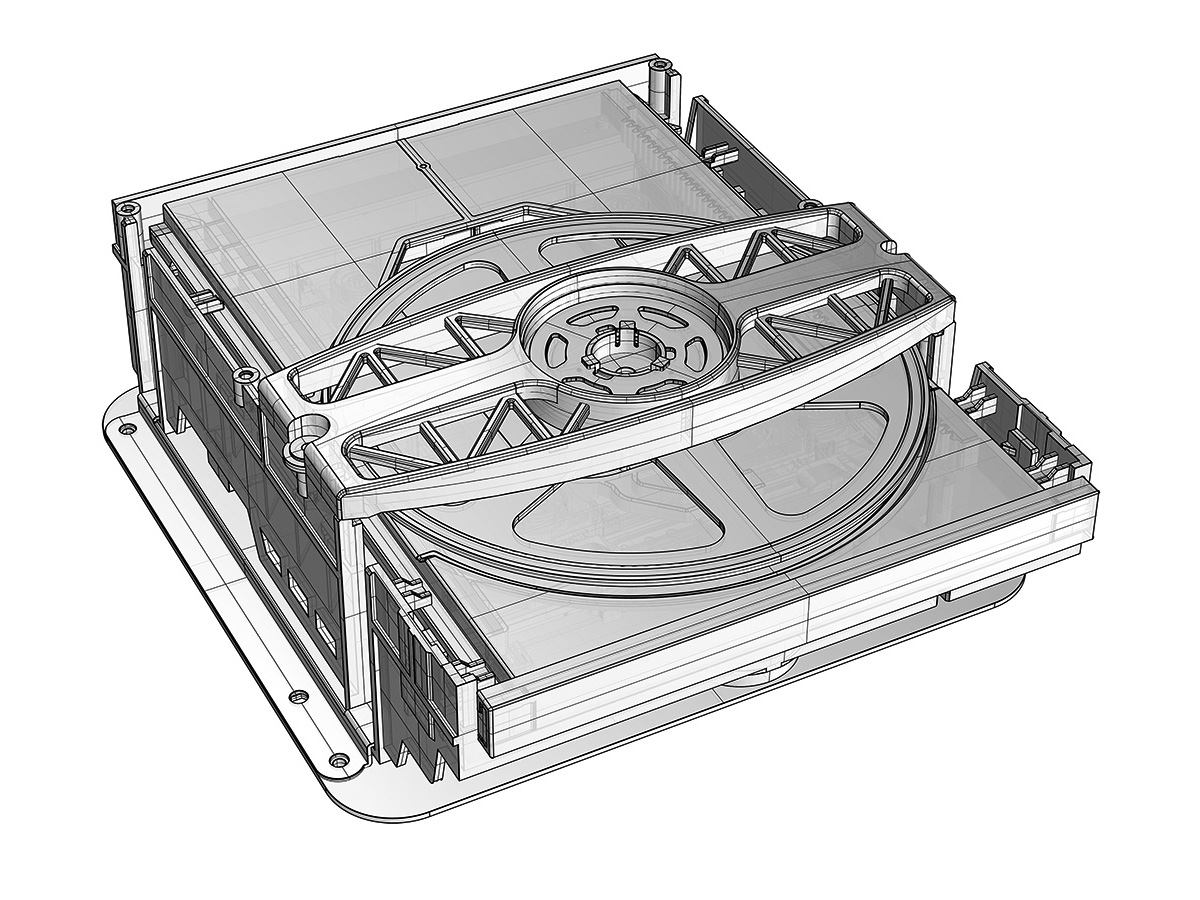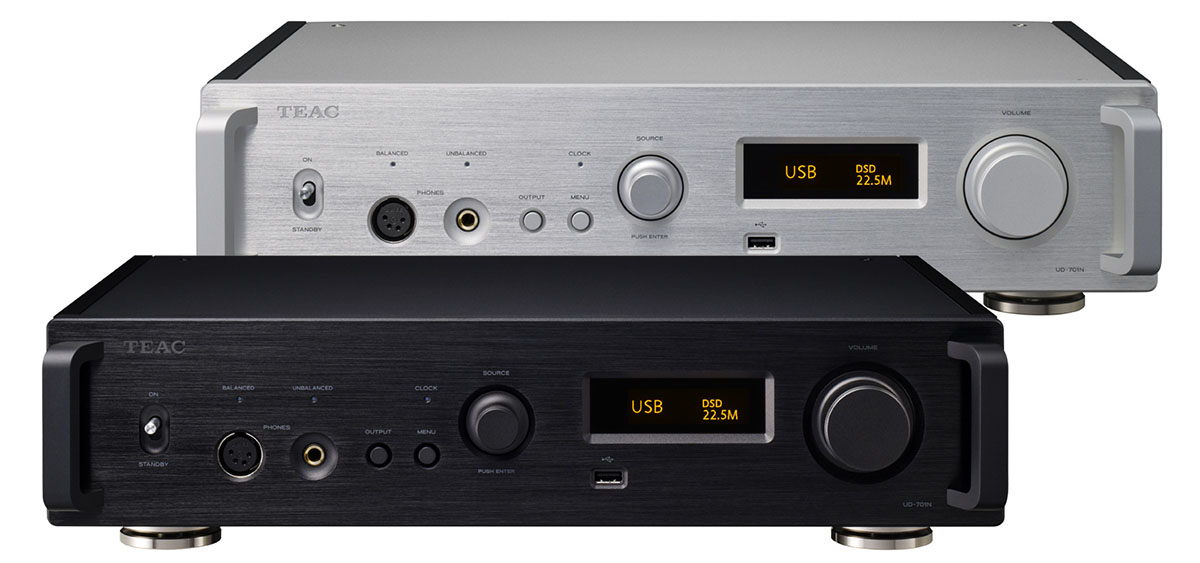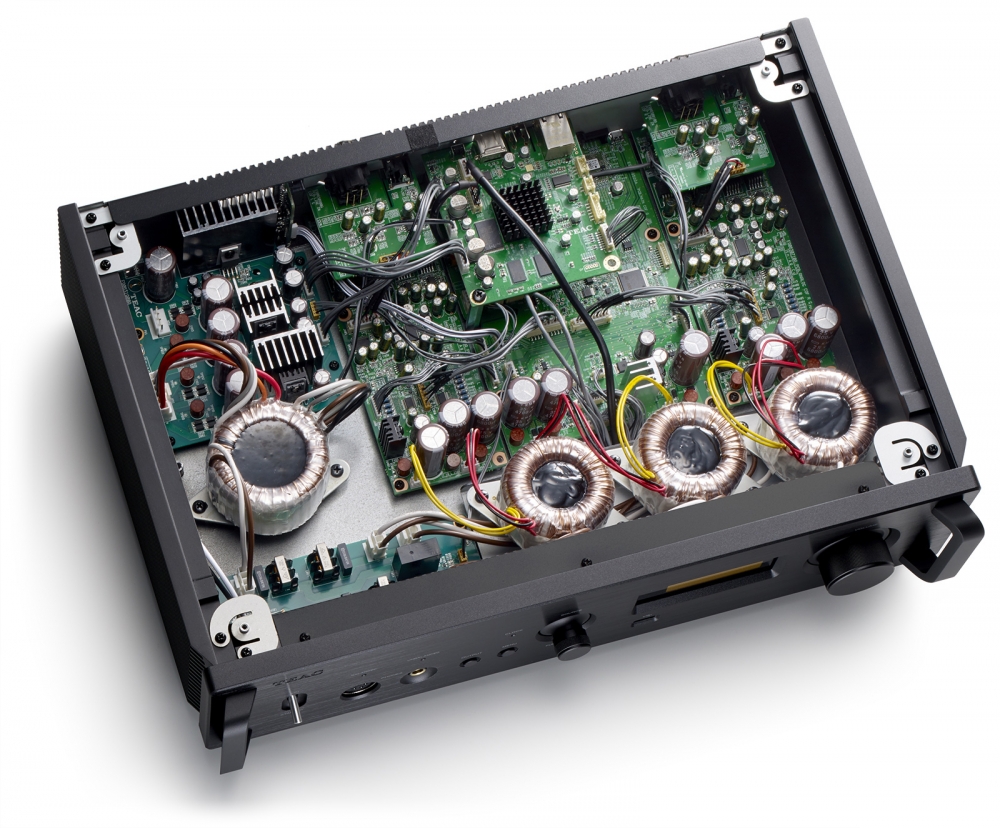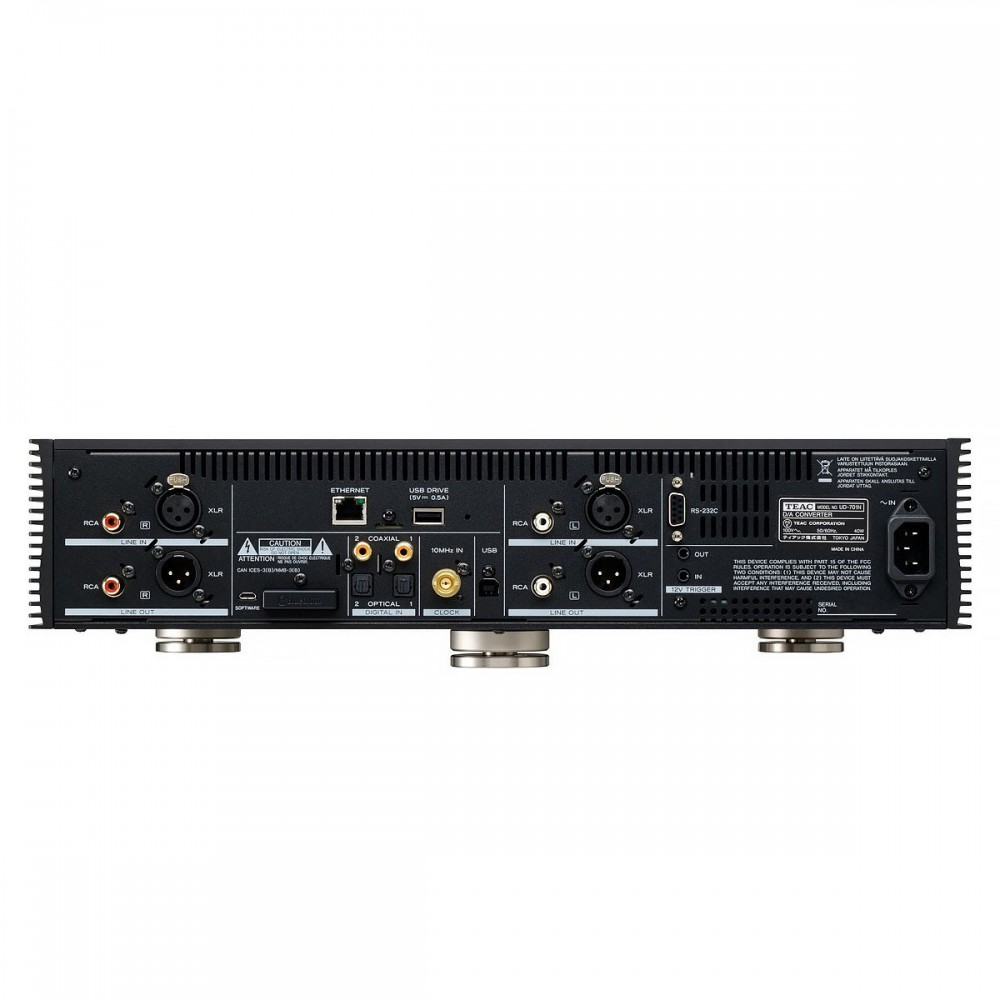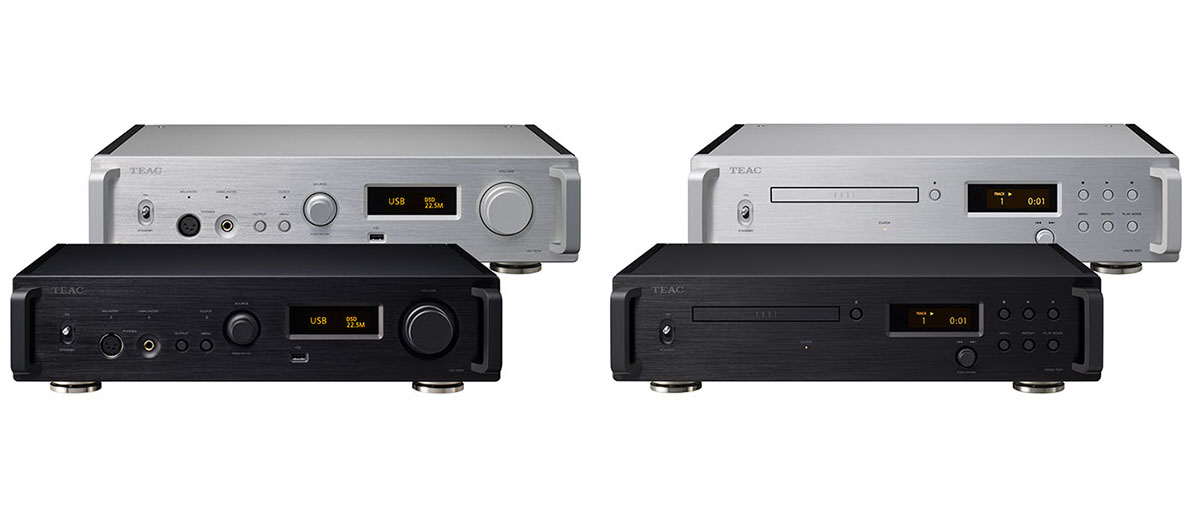Today, I’ll be checking out TEAC’s VRDS-701T CD transport UD-701N DAC/Network Player/Pre-amp. For simplicity, the transport will be referred to as the 701T and the pre-amp as the 701N. We also tested both units as a single ‘source system.’ All one needs to do is add a power amp and speakers, or powered speakers or headphones, and the system is complete.
The ‘VRDS’ in the 701T is short for ‘Vibration-Free Rigid Disc-Clamping System,’ which TEAC states is derived from their luxury brand Esoteric’s Grandioso CD transport. The concept is to reduce vibration organically. The CD mechanism is anchored on one side, with the other in a semi-floating state, reducing vibration levels. The optical disc is joined to a turntable of equal diameter, increasing structural strength and lowering any chance of warping. As a CD transport, the 701T requires a separate DAC, with its natural pairing being the 701N.
The UD-701N USB DAC combines a DAC with a fully balanced, two-input (RCA + XLR) line-level/two-output (RCA + XLR) preamplifier and a two-output headphone amplifier (four-pin XLR and quarter-inch jack). We are going to explore how well the two units work in terms of creating an elevated digital audio experience.
VRDS-701T CD Transport
- VRDS semi-floating mechanism.
- Enhanced digital output
- MQA core decoder
- 10 MHz external clock input
- Two high-capacity toroidal core transformers
- Power transformers on a floating structure
- Vibration-reducing steel pinpoint feet (three in total)
- Fully functional remote control
UD-701N USB DAC Preamplifier
- TEAC ΔΣ (Delta Sigma) discrete DAC
- User-selectable one-bit or multi-bit conversion
- Dual mono structure
- Fully balanced transmission at every stage
- Four high-capacity toroidal core transformers
- Dual analog pre-amp inputs (1x RCA, 1x XLR)
- Four digital inputs (two coaxial / two optical)
- TEAC-QVCS (Quad Volume Control System)
- HCLD2 (TEAC High Current Line Driver) output buffer circuits
- Four-pin XLR headphone amplifier
- MQA full decoder
- 384 kHz up-conversion of PCM digital audio signals
- Bluetooth® receiver supports LDAC, aptX™ HD
- Roon ready and OpenHome ready
- TEAC HR Audio Player for 22.5MHz DSD playback with Windows and Mac
- Fully operational remote
TEAC was founded in 1953 by Katsuma Tani and has one of the most credible histories in the world of audio and video. For example, in 1964, the world’s first slow-motion video recorder made by TEAC was used at the Tokyo Olympics to record the movements of the athletes. The company has always taken the path of using proper engineering to make accurate audio, and over the decades, its track record is second to none in this arena.
The two components in for review, the VRDS-701T CD Transport and UD701N Preamp/DAC/Streamer are textbook examples of TEAC’s ability to engineer into a product a wealth of proprietary engineering and manufacturing concepts that, when done, can make great music. Both components were built to an elevated standard, from the floating mechanisms throughout to separate power supplies and high-quality components. When one lifts either the 701T or UD701N, one feels the solid construction and almost industrial presence that is all things TEAC. With all that in mind, let’s find out if all this engineering can be musical.
Supported media:
Audio CD, CD (CD-R/CD-RW) * 8cm CDs not supported.
Digital audio outputs:
COAXIAL, RCA × 1
Output level:
0.5V p-p
Output impedance:
75Ω
OPTICAL:
Connector: TOS (JEITA RC5720C) × 1
Clock sync input:
Connector: BNC × 1
Input frequency:
10MHz
Input impedance:
50Ω
Input level:
Sine wave: 0.5 to 1.0 Vrms
External control:
Trigger in (12V TRIGGER IN)
Connector:
3.5mm Mono mini jack × 1
Input level 12V, 1mA
Trigger out (12V TRIGGER THRU) / Connector: 3.5mm Mono mini jack × 1
Output level 12V
Maximum current supply:
100mA
Power:
AC120V, 60Hz
AC:
220-240V, 50/60Hz
Power consumption:
10W
Standby power:
0.4W
Overall dimensions:
444 (W) × 111 (H) × 333 (D) mm (including protrusions)
Weight:
10.1kg
Operating temperature:
+5°C to +35°C
Operating humidity:
5% to 85% (no condensation)
Storage Temperature Range:
−20°C to +55°C
Included accessories:
AC cord, Remote control (RC-1338), AAA batteries × 2, Foot pads × 3, Owner’s manual
MSRP:
$2699.99
Website:
Company:
SECRETS Tags:
teac, cd, transport, dac, delta-sigma, streamer
DAC:
TEAC ΔΣ Discrete DAC × 2
Up-convert:
2xFs / 4xFs / 8xFs (maximum 384kHz)
Analog audio inputs:
Balanced Connectors XLR × 1 pair
Input impedance:
50kΩ
Maximum input level:
5 Vrms
Unbalanced:
Connectors RCA Pin (gold-plated) × 1 pair
Input impedance:
25kΩ
Maximum input level:
2.5Vrms
Digital audio inputs:
USB Connectors USB B-type × 1, (USB2.0 compliant)
Supported formats:
PCM 16/24/32-bit 44.1k/48k/88.2k/96k/176.4k/192k/352.8k, 384kHz
DSD:
2.8M/5.6M/11.2M/22.5MHz
Coaxial:
Connectors: RCA Pin (gold-plated) × 2 pairs
Input level:
0.5V p-p
Input impedance:
75Ω
Supported formats:
PCM: 16/24bit 32k/44.1k/48k/88.2k/96k/176.4k, 192kHz
DSD:
2.8MHz (176.4kHz/24-bit DoP format)
Optical:
Connectors Rectangular (TOS) × 2 pairs
Input level:
–24.0 to –14.5dBm peak
Supported formats:
PCM16/24bit 32k/44.1k/48k/88.2k/96k/176.4k, 192kHz
DSD:
2.8MHz (176.4kHz/24-bit DoP format)
ETHERNET:
Connector RJ-45 × 1 (1000Base-T)
Supported formats:
PCM16/24/32-bit 32k/44.1k/48k/88.2k/96k/176.4k/192k/352.8k, 384kHz (Stereo)
DSD:
2.8M/5.6M/11.2M/22.5MHz (Stereo)
Supported formats:
PCM lossless, FLAC, Apple Lossless (ALAC), WAV, AIFF, MQA
DSD lossless, DSF, DSDIFF (DFF), DoP
Compressed audio:
MP3, AAC (m4a container)
USB flash drive:
Connectors USB A-type × 2 (Front × 1, Rear × 1, USB2.0 compliant)
Supported file system:
FAT32, exFAT, and NTFS single partition
Supported file format:
PCM16/24/32-bit 32k/44.1k/48k/88.2k/96k/176.4k/192kHz/352.8k/384kHz (Stereo)
DSD:
2.8M / 5.6M / 11.2M / 22.5MHz (Stereo)
Supported file formats:
PCM lossless, FLAC, Apple Lossless (ALAC), WAV, AIFF, MQA
DSD lossless DSF, DSDIFF (DFF), DoP
Compressed audio MP3, AAC (m4a container)
Bluetooth®
Bluetooth® version: 4.2
Output class Class2 (range: 10m)
Supported profile:
A2DP, AVRCP
Supported A2DP codec LDAC, LHDC, AAC, SBC, Qualcomm®aptX™ audio/HD audio
A2DP content protection SCMS-T
Number of saved pairings:
Maximum 8
Analog audio outputs:
Balanced Connectors XLR (gold-plated pins) × 1 pair
Output impedance:
220Ω
Output level settings:
Selectable from Fixed (0dB), Fixed (+6dB), Variable, or Off
Maximum output level:
2.0Vrms (1kHz, Full-scale, 10kΩ loaded, Fixed at 0dB)
4.0Vrms (1kHz, Full-scale, 10kΩ loaded, Fixed at +6dB)
12Vrms (1kHz, Full-scale, 10kΩ loaded, Variable)
Unbalanced:
Connectors RCA Pin (gold-plated) × 1 pair
Output impedance:
180Ω
Output level settings:
Selectable from Fixed (0dB), Fixed (+6dB), Variable, or Off
Maximum output level:
2.0Vrms (1kHz, Full-scale, 10kΩ loaded, Fixed at 0dB)
4.0Vrms (1kHz, Full-scale, 10kΩ loaded, Fixed at +6dB)
6.0Vrms (1kHz, Full-scale, 10kΩ loaded, Variable)
Headphone outputs:
Balanced Connector 4-pin XLR × 1
Pin assignment:
Pin1: L+, Pin2: L–, Pin3: R+, Pin4: R–
Unbalanced Connector:
6.3mm Stereo jack (gold-plate) × 1
Maximum output power:
Balanced 700mW + 700mW (32Ω loaded)
Unbalanced 500mW + 500mW (32Ω × 1 loaded)
Supported impedance:
16 to 600Ω
Clock sync input:
Connector BNC (gold-plated) × 1
Input frequency:
10MHz
Input impedance:
50Ω
Input level:
Rectangle wave: Equivalent to TTL Sine wave 0.5 to 1.0Vrms
External control:
Trigger Input (12V TRIGGER IN)
Connector:
3.5mm Mono mini jack × 1
Input level:
12V, 1mA
Trigger output:
(12V TRIGGER THRU)
Connector:
3.5mm Mono mini jack × 1
Output level 12V
Maximum current supply 100mA
Audio performance:
Measurement conditions: Input signal: 192kHz/24-bit PCM, Measurement output: RCA, DAC low-pass filter: On
Frequency response:
5Hz to 80,000Hz (+1dB/–5dB)
Total harmonic distortion:
0.002%
S/N ratio:
108dB (A-Weight, 1kHz)
Power:
AC120V, 60Hz / AC220 – 240V, 50/60Hz
Power consumption:
40W
Standby power:
0.4W
Overall dimensions:
444 (W) × 111 (H) × 334 (D) mm (including protrusions)
Weight:
11.8kg
Operating Temperature:
+5°C to +35°C
Operating Humidity Range:
5% to 85% (no condensation)
Storage Temperature Range:
–20°C to +55°C
Included accessories:
Power cord, Remote control (RC-1330), AAA batteries × 2, Owner’s manual, Footpad x 3
MSRP:
$4299.99
Website:
Secrets Sponsor
The VRDS 701T CD Transport was the first component unpacked for this review, and my first impression was a product of intense structural integrity. It weighs in at over 22 pounds as a CD transport with no on-board DAC. The front panel is thick aluminum, and the sides incorporate heat sinks. When picking it up, one will get the feel that it’s a serious audio component. The design goal was to deliver a vibration-free digital signal into the DAC of one’s choice, and considerable engineering went into this design.
The stout exterior chassis is anchored by a trio of steel pinpoint feet that employ a traditional TEAC design with a new structure to provide a suitable amount of play in the connection between them and the bottom panel, which are used to control vibrations that could affect audio quality. At first glance, this trio of feet may feel ‘loose’ as they have a lot of ‘play’ and make a sharp sound when putting the 701T on a surface. What they actually are is the first line of defense in keeping vibrations from reaching the transport mechanism itself.
The Vibration-Free Rigid Disc-Clamping System (VRDS) is the star of the show. The disc is encased in a resin-based material which is quite inert on its own. The disc and its resin casing are then clamped to an aluminum turntable with the same diameter, maximizing inertial mass in order to stabilize rotation. Servo current is reduced with the turntable by correcting disc warping and distortion and improving the relative optical axis precision of the pickup and disc pit side. This is intended to reduce, if not eliminate disc reading errors and preserve audio quality. (picture attached of this mech)
The VRDS is attached to yet another vibration-reducing component of the chassis, called the bridge, which has a torus structure made of resin and is only fixed on one side. Propagation of vibration from the CD mechanism to the opposite side through the bridge is suppressed, so the entire mechanism minimizes unwanted sympathetic vibrations.
Dual high-capacity toroidal core transformers are dedicated to the digital control section and the CD mechanism with each getting a dedicated transformer. Applying these two high-capacity toroidal core transformers enables current to be supplied with greater stability. The power transformers are also isolated on a floating structure.
The 701T has an internal 10 MHz clock for use with the optional CG-10M Master Clock Generator (we did not have the CG-10M available for the review, so consider this a future upgrade possibility) and MQA decoding.
The remote has a quality feel to it and handles all normal CD functions along with up-conversion and filters. The front panel is well laid out with disc open, play/stop functions, a menu, and an easy-to-read display.
The UD-701N Preamp/DAC/Streamer weighs in at over 26 pounds and shares the same build quality as the 701T, including the same vibration-reducing trio of feet.
The 701N has two primary functions in terms of accepting digital audio: The first is to take the signal from the 701T and turn it into an analog signal. It does so through TEAC’s ΔΣ (Delta Sigma) discrete DAC comprised of discrete circuitry that uses an FPGA incorporating TEAC’s proprietary algorithms. DSD signals are transmitted as is, while PCM signals are transmitted after passing through the ΔΣ modulator and conversion to either one-bit or multi-bit signals according to the listener’s choosing. With the TEAC ΔΣ discrete DAC, playback of 22.5MHz DSD and 384kHz/32-bit PCM is possible.
The second is the streamer, with Spotify Connect, Qobuz, Tidal, and TuneIn internet radio. LDAC™ and LHDC codecs, which can transmit audio data with quality that is considered high resolution (96kHz/24-bit), are supported, as is Qualcomm® aptX™ HD, which is capable of 48kHz/24-bit transmission.
AAC, Qualcomm® aptX™, and SBC codecs are also featured, allowing high-quality wireless playback from smartphones and digital audio players.
The front panel is well laid out, with both the four-pin XLR (balanced) and quarter-inch unbalanced headphone outputs on the left side of the unit. Next is the most welcome output button, which allows easy switching between the XLR and quarter-inch headphone outputs along with RCA and XLR main outputs to one’s power amp or powered speakers. The Menu button, Source knob, USB port, Display, and Volume controls complete the front panel.
The pre-amp section employs two toroidal core transformers for the independent left and right analog signals. Separate toroidal core transformers are also used in both the network module and digital control sections. You are reading that correctly, there are four separate core transformers.
The remote matches the 701T’s functions while adding switching between DAC inputs and analog inputs, along with up-conversion, filters, and volume control. Up-conversions are up to 8xFS or 382kHz, which was employed for all listening tests.
Both the 701T and 701N are full-featured units, and it is recommended that one take the time to read through the manuals for each product. Space does not permit including all the features these two well-executed examples of audio engineering offer.
As the 701T CD transport and 701N pre-amp, DAC, and headphone amp were used as a two-piece system, all serious auditioning was done with two basic systems. The first system consisted of the VRDS-701T with a Clarus Cable Aqua RCA cable connecting the output of the 701T to the Coaxial input of the 701N pre-amp. The 701N was connected to a Michi S5 power amp, which fed a pair of Audiovector Trapeze RI floor-standing speakers. The cables from the 701N to the Michi S5 were Clarus Aqua XLR cables and the Michi amp was connected to the Audiovector speakers via Clarus Aqua speaker cables. Power was filtered through a Clarus Concerto conditioner.
The second system left out the Michi amp and Audiovector speakers while adding a pair of HIFIMAN Isvarna headphones. The headphone amp built into the 701N warrants exploring with some top-tier headphones, and the $2900 Isvarna cans from HIFIMAN fill that role nicely.
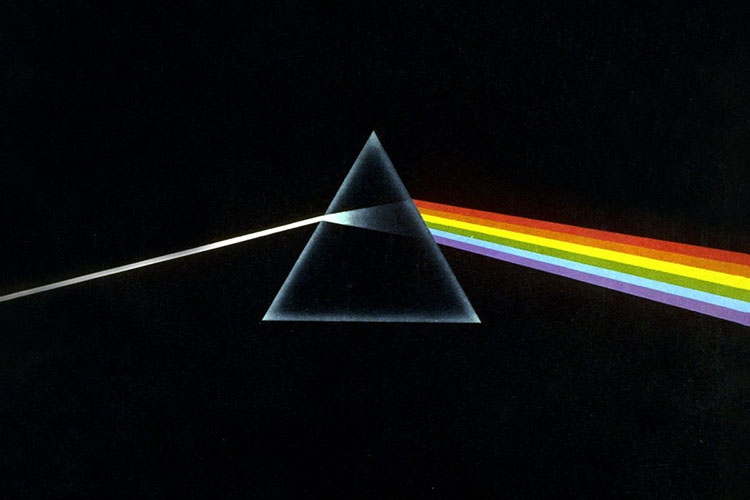
Pink Floyd: Dark Side of the Moon
Opening with ‘Speak to Me’ with its pulsing bass line and ticking clock effects, the TEAC 701 Duo immediately impressed with a silent background and well-defined detail in delivering the fine micro-dynamics of this introduction piece. The crescendo leading into ‘Breath’ from this $7,200 CD Transport and Pre-amp into the $29,000 Audiovector Trapeze RI / Michi S5 combo was one of sheer menacing volume without a hint of harshness.
The footfalls in ‘On the Run’ show off this delicate detail ability of the TEAC duo to present even the most immediate notes with precision in terms of soundstage. In other words, the runner traversed the room with authenticity. ‘Time’ soars into the room with nape-hair-raising clarity and power from all the chimes and bells going off; then settles into the percussion and guitar work that has mesmerized millions of listeners for half a century. The TEAC 701s relished delivering every note and vocal with detail that will be at home in even the most high-end system.
‘The Great Gig in the Sky’ with Clare Torry’s powerful vocals continued the show, and without a hitch, the VRDS-701T and UD-701N teamed up to bring to the Audiovectors a clean, detailed presentation that was more than worthy of one of the most famous songs ever recorded without being a single hit of its own. The entire disc was so well played through this system that a thought process had already started which led to a conclusion that the TEAC top-of-the-line CD Transport / DAC / Pre-amp would be at home as a reference component system, regardless of the price.
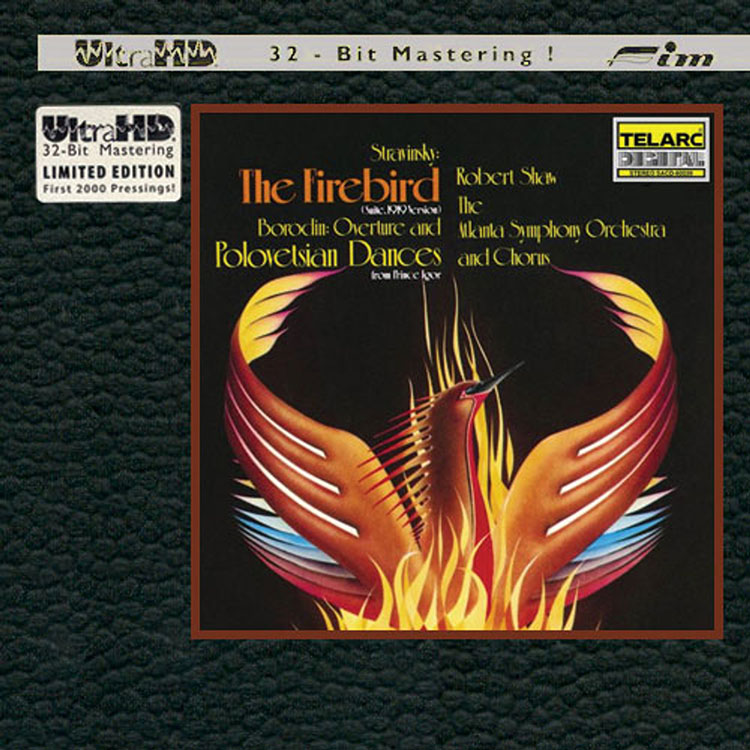
Stravinsky “The Firebird” Limited Edition Ultra HD CD
This 32-bit high-resolution CD is a music lover’s 45-minute escape. Applying the 32-bit/384 kHz up-conversion setting and what seemed to be a moderately low volume setting in terms of SPL being delivered, the disc opens with the relatively laid-back bass cello introduction. Through the TEAC 701 twins, the background was the deepest black, with the bass being presented in both an agile manner and with depth and power. ‘The Firebird Suite’ lets the flute section and brass loose in a most light-hearted fashion, with a requirement that the system in its entirety is lightning quick, and the TEAC front end delivers the goods with a strong sense of a proper stage for the musicians as individuals. ‘Round Dance of the Princesses’ features the violin section, and we are still staying with moderate volumes and a slow, easy timing. One is drawn into the performance as if one is being the subject of a whispering conversation. Three selections into the disc, and the listener is leaning forward a bit.
Then ‘Infernal Dance of King Kastchei’ kicks in with the thunder. The bass drum thwack is a solid 20 dB above what we were hearing, and the dynamic requirements from this disc on the components involved reward the listener with what would be called a jump scare in a movie. The TEAC 701s hit this dynamic in a manner that left a smile on my face. This fourth track also features an increase in tempo and intensity throughout, with the brass, strings, and percussion compelling the feeling that one must straighten one’s posture. The 44 minutes of pure, un- amplified music is a true test of any two-channel system. The TEAC VRDS-701T and UD-701N again proved the engineering prowess of the team at TEAC.
Bluetooth Bliss
I spent over 100 hours of casual listening to various artists on Spotify and Quboz. The overall experience was more than positive. While critical listening is not something I do via streaming, the UD-701N was as good as any other pre-amp has been in our system. Anyone reading this can be confident that TEAC has you covered if you want solid performance from any of the streaming sources.
The HIFIMAN Isvarna Headphones Enter the Building
The Isvarna headphones retail for $2,900 and offer extension from 6 Hz to 60 kHz, sensitivity @ 93 dB, and impedance of 16 ohms. They offer an excellent foundation for listening tests featuring the TEAC 702 duo as a $7,000 Transport-DAC-Streamer-Headphone amp. With the Isvarna headphones, one could look at the three products as a singular $9,900 turnkey audio center.
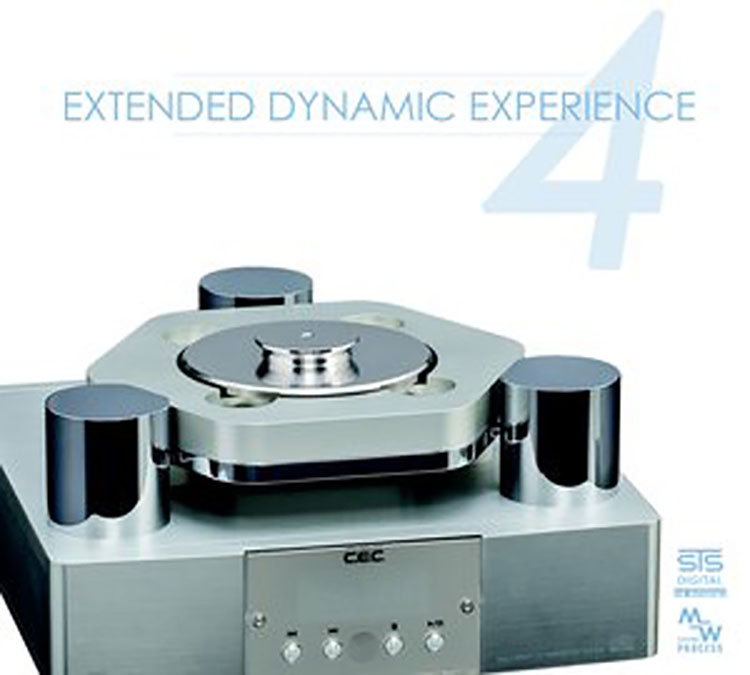
Extended Dynamic Experience IV
As this wonderfully recorded CD is endowed with a variety of music challenges, it has become a standard favorite for evaluation. Opening with Bella Fleck’s ‘Flight of the Cosmic Hippo,’ the listener is treated with deep, rich, layered bass lines that are pitch-perfect while placing the bass inside one’s aural center. The guitar is placed in front of the listener with the percussion centered with the bass line. One other item of note is the complete silence from the TEAC pair. There is not a whiff of audible noise. The music merely… HAPPENS.
Yello’s – ‘Rubberbandman’ has the TEAC/HIFIMAN trio showing off the baritone vocals with nary a hint of boom. The experience is just more depth and authentic feel while the percussion and synthesized wind noises swirl around one. The headphone-centered system brings a different window into the music than does a high-end pair of speakers. One is more centered than in an audience, and low noise is even more important, and again the 701 twins prove themselves to be capable of delivering exactly what the engineers put on the disc.
Dede Priest is next up with ‘Blues Wine,’ and her silky vocals are placed inside one’s ears, which is a sublime location for a voice this smooth. The engineering of the 701 twins is again made abundantly clear by treating us to more complete silence, excellent bass extension, and a layered, analog high-end quality to a digital signal. I found myself thinking about the dozens of discs that warranted a serious listen with this incredibly detailed, nuanced, and powerful three-piece audio center.
The rest of ‘Dynamic Experience 4’ is more of the same. Bass lines that seemed to have no bottom, a whirling surround treat that bordered on thrilling, smooth midrange and highs all coming from a totally silent, black background. The TEAC VRDS-701T and UD-701N proved themselves to be very close to ‘as good as it gets’ in terms of sound quality. It would be a terrific test to find a proper way to blind-test the 701 duo against some cost-no-object components. It’s likely that the TEAC pairing would be quite competitive in this type of test.
Secrets Sponsor
TEAC’s VRDS-701T CD Transport and UD-701N Preamp/DAC/Streamer are a fantastic way to enjoy CDs and streamed music. For the money, they have few equals.
- Both units are built like tanks
- TEAC’s use of their own components, especially in the DAC
- Excellent remote controls
- Bass extension and authority that is above the price paid
- Silent background
- Transparent sound quality with deep layering of subtle cues
- Unrestricted dynamics
- They look like they mean business
- Isolation feet based on solid engineering
- How TEAC combined accuracy with musicality
- A TEAC transport that supports SACD
- More Toslink and Coax inputs
A CD transport combined with a Pre-amp/DAC/Streamer is not as exciting a product as is a pair of loudspeakers. The primary goal of these components is to turn a digital signal into an analog signal, amplify the voltage, and feed that amplified signal to a power amp or powered speakers. The best units add no sonic signature of their own and these components deliver this signal with no degradation from below 10 Hz to well above 20 kHz. It is this sheer demonstration of the excellent design and engineering work from TEAC’s team that brings excitement to the 701T and 701N.
The TEAC VRDS-701T CD transport and UD-701N Pre-amp are adept performers at every level. The deepest bass notes will challenge any full-range speaker’s ability to deliver what the TEAC twins are sending. The midrange is neutral and musical with the highs extended and clear while never being etched. They can drive most amplifiers with ease, and to this reviewer’s ears, they deliver an accurate, authoritative performance that is among the best available, regardless of cost.
For $7,000, they are a high-value system that is worthy of the highest of recommendations.


